Freckles, Red Hair, Neandertals, Denisovans, Melanesians, Wild People, Bigfoot and Beautiful People
Posted by: Loren Coleman on December 7th, 2011

The paleoanthropologist John Hawks (above) is undertaking a worthy mission at his blog this week, detailing his and his students’ “investigation of pigmentation-related loci in archaic humans.”
For hominologists, trying to make sense of local and native traditions and ongoing sightings of hairy wild people, Yeren, Yeti, and Bigfoot, there is much to be learned from what various groups of hominids might have looked like. Hawks, et alii, are attempting “to determine what we can about the physical appearances of Neandertals and Denisovans.”
A great deal has already been discovered about what ancient (archaic) peoples looked like.
What do we know about the physical notions about the Siberian Denisovans?
Hawks previously hinted at some of his thoughts when he penned a posting, “Denisovans did not have red hair.”
Despite Denisovans being found in Siberia, what is surprising some genetic researchers is that the Denisovans appear to have added DNA material to, for example, Melanesians. In Reich, et alii, papers summarized in “Evidence of ancient admixture between the Denisova and anatomically modern human from Southeast Asia, Oceania, and New Guinea,” estimated that the Denisovans contributed “up to 7% of genetic materials of modern people from [those] areas.”
The modern media translated this into saying that the Denisovans are still living in the genetic makeup of the Melanesians. Perhaps this is partially true, but what does that tell us about what they really looked like? Well, I can have patience as Hawks unfolds what he wants to tell us, but I thought I’d throw in some images to ponder while we wait.
Variation among people in all populations is great. Would we think the Denisovans were appealing?
Is beauty in the eyes of the beholders, or in our genes?
Melanesians are remarkable looking people, attractive, no doubt, within and outside their own breeding populations.
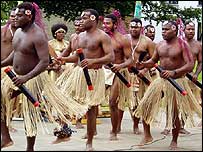

The traditional (above) and modern (below) view of Melanesians has an appeal to our human sense of beauty, won’t you say?

When it comes to what Neandertals looked like, are we pre-disposed to think they appeared to be “ugly,” whatever that means?
Certainly, my education system in elementary school, with old texts and misunderstandings of early findings, didn’t help.
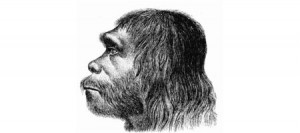
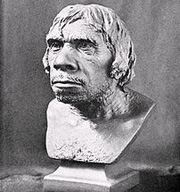
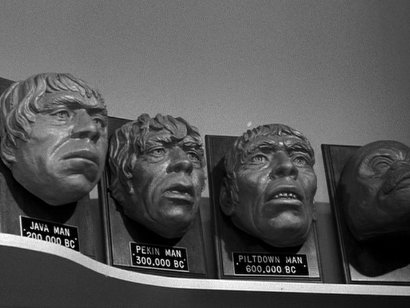
Today, even to use the word “Neandertal,” in conjunction with certain people, gives us mental images of whom we are dealing with…doesn’t it?

As John Hawks points out in his new posting and previously, we are in the midst of a time of major revisions in how we think about the appearance of Neandertals. Genetic studies are confirming (btw, as they have with Pleistocene mammoths) that Neandertals had red hair. Hawks’ posting, “The ‘flame-haired’ Neandertals” hit home with the DNA facts, earlier in 2007. Apparently, Neandertals probably had (or have, if you consider present survival a possibly) freckles too. Do they, if they are still “in us,” show themselves via red hair, freckles, and Celtic toes?
Of course, the initial 2007-2008 media presentations of the red-haired Neandertals were, well, rather harsh:
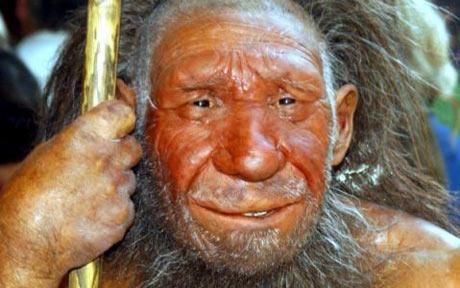
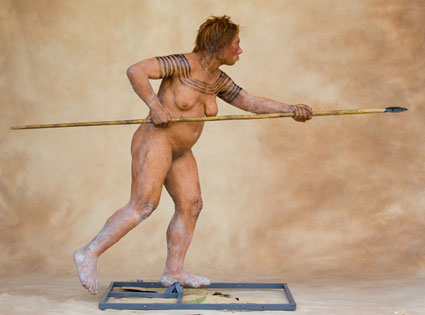
Predictably, National Geographic did tone down the robust nature of, at least, one freckled Neandertal face:
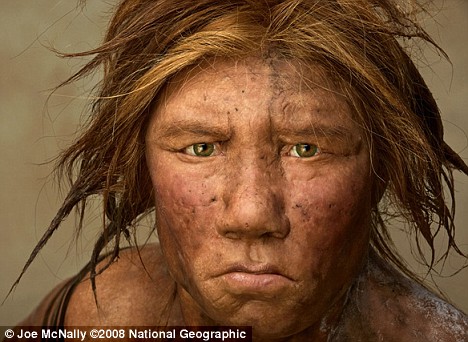
Perhaps it is my Eastern Band Cherokee-Scottish genetic makeup, but I tend to agree with those who find red hair and freckles are awesome. Ah, Neandertals are a lot more attractive that the mainstream media wants to admit.



Unfortunately, due to the popularity of South Park, “Ginger Kids” jokes are too common in America today, and a new minority group of freckled, red-haired, left-handed, Celtic-toed people have been marginalized through humor and posters such as the following:
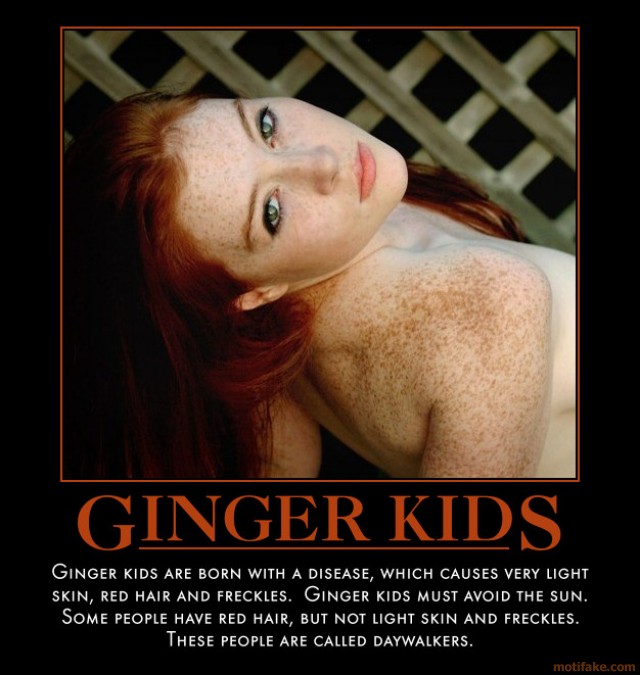
John Hawks need not worry about those of us who are seriously interested in his work, and how it might apply to Sasquatch studies, Yeren research, and Yeti expeditions. He has much more to fear from the future South Park quips now being developed by comedy writers who have discovered the fertile ground in the findings of his and his associates’ genome research.
About Loren Coleman
Loren Coleman is one of the world’s leading cryptozoologists, some say “the” leading living cryptozoologist. Certainly, he is acknowledged as the current living American researcher and writer who has most popularized cryptozoology in the late 20th and early 21st centuries.
Starting his fieldwork and investigations in 1960, after traveling and trekking extensively in pursuit of cryptozoological mysteries, Coleman began writing to share his experiences in 1969. An honorary member of Ivan T. Sanderson’s Society for the Investigation of the Unexplained in the 1970s, Coleman has been bestowed with similar honorary memberships of the North Idaho College Cryptozoology Club in 1983, and in subsequent years, that of the British Columbia Scientific Cryptozoology Club, CryptoSafari International, and other international organizations. He was also a Life Member and Benefactor of the International Society of Cryptozoology (now-defunct).
Loren Coleman’s daily blog, as a member of the Cryptomundo Team, served as an ongoing avenue of communication for the ever-growing body of cryptozoo news from 2005 through 2013. He returned as an infrequent contributor beginning Halloween week of 2015.
Coleman is the founder in 2003, and current director of the International Cryptozoology Museum in Portland, Maine.










Neanderthals contributed the red-haired & freckled gene? Fine by me… I loves me some Celtic freckled red-haired ladies. Bring on the Gingers!
You’re a bad lad, Loren Coleman, a bad lad!
…saying that, based on that row of four heads on plaques, no wonder the Beatles made so little money out of Brian Epstein’s merchandising efforts.
p.s.
You can have the Denisovan lady with hoop tattoos and the spear – I’ll settle for the Melanesian lass in pale lilac…though I’m not unpartial to freckles…freckles yes…hoops no…or spears…unless someone like Xena’s pointing them at me…
I just watched a talk on this subject the other day on TED talks by Svante Paabo very interesting.
mjolnir1964 totally agree with ya. Love me a red headed Irish women. Also I want to thank the Geico cavemen for providing us with laughter and the daywalker gene.
in followup to alan borky’s post above, those four supposed Neanderthal busts on placques all look like variants of James Coburn with a Beatle’s type haircut don’t they? Coburn must have had 99% Neanderthal genes if those busts are anywhere close to being accurate. LOL.
I think that it’s appropriate here to stop and consider the fact that just because a gene, such as the one for red hair and freckles, is present in someone’s DNA it doesn’t necessarily mean that gene will express itself. Genes are either dominant or recessive, and may be dormant or active, depending on how other genes and the proteins they code manipulate its expression. Sometimes you just can’t tell what any particular gene is going to do. The Neandertals may not all have had the gene for red hair and freckles, they may all have had it and it remained unexpressed in some part of the population. Lighter skin such as goes with red hair is probably advantageous for vitamin D production when little of the skin is exposed to sunlight due to Ice Age temperatures requiring the constant wearing of clothes, plus the Northern latitudes they seem to have mostly inhabited.
I will have to return to Dr Hawk’s site..it is interesting and BTW he was aware of the Sierra Kills and Ketchum, but gave up no details. He has several grad students that follow this closely.
That said, I’ll go to his site also because of all the photos you could select for the lead in to the article you, Loren?, picked the one with BIG BOOBS and baby oil! Geez no wonder so many Bigfooters are still stuck in ape land, they are apes themselves!
Add me to the list of Ginger-loving Cryptomundians!
And I just wanted to point out that re-constructions have ALWAYS been biased. Case in point (and not that I want to turn this into a religious debate) the time when National Geographic made a re-construction of a 1st century Jew to “show” how Jesus might have looked like.
Everywhere you could see newspapers and magazines showing the image as if it was the *actual* reconstruction of Jesus, and every time I kept thinking “Puh-leeese! does that schmuck look like a charismatic Rabbi capable of drawing thousands of people to his sermons?”
I’m beginning to suspect that modern humans are less a “species” and more a hybrid of just about every hominid that came before.
I feel it must be pointed out that the supposed “red hair” gene possessed by Neanderthals is separate from that found in Modern Humans. That is to say that no one currently alive has inherited red hair from Neanderthal ancestors.
People tend to overlook that very important detail and then proclaim that anyone with red hair is a Neanderthal. They had an entirely different gene with a similar effect and that’s it.
Another thing that must be pointed out is you referring to those depictions of Neanderthals as “harsh”. They were stocky, chinless, low-foreheaded, huge nosed people with very robust features, and that’s a fact. They already underplay those features too much in modern reconstructions, to the point where their browridges look less developed then some modern humans when I know for a fact that going by the actual bones it shouldn’t be that way.
Take a look at real modern human Hunter-gatherers with robust features like Australian Aborigines who while certainly less robust then Neanderthals in reality somehow seem to possess more robust features then these reconstructions. This being a clear sign that the underplaying has gone too far, at least in my opinion.
When one actually understands the underlying bone structure they can see that the National Geographic “Wilma” reconstruction is actually rather prettied up despite the dirt on her face. Real Neanderthals would’ve been uglier.
Another thing to add is that for whatever reason whenever they try to make Neanderthal look less “ugly” they always do so by trying to make it more “White” despite the fact that they have no closer genetic tie to “White” people then to Asians for instance. They weren’t “White” or any other race and special effort shouldn’t be made to make it look otherwise. I always find it slightly disturbing when they attempt just that.
Thanks to everyone for your comments, which demonstrate an entertaining variety of human responses and insights. People reacted to this posting, and hopefully will now follow John Hawks’ words on the topic.
Krakhed’s response has the tone of thoughtful discussion I was hoping for, in general. I appreciate Krakhed sending these observations along after the first wave of reactions.
When I wrote, “Predictably, National Geographic did tone down the robust nature of, at least, one freckled Neandertal face,” I too saw NatGeo as attempting to do one of their rewrites of history.
I am reminded of NatGeo’s painting of the first Homo foresiensis find, where their “Hobbit” was depicted as a male. The first fossil discovery of Homo floresiensis was of a female, not a male.
I have to agree with Krakhed’s comments that “white” is the common theme here, although perhaps more specifically, it too often is European, CroMagnon, and male.
Well I’m not too sure about them reconstructing Neanderthals to look Cro-Magnon, though they sometimes try to make Cro-Magnons look as primitive as possible when they were simply rather normal physically fit people with well-formed jaws and cheekbones.
And how could they try to make Neanderthals look like Cro-Magnons? That would require them to know the exact soft-tissue qualities that Cro-Magnon possessed, and even the details they do know are often ignored to give Cro-Magnon blue eyes that hadn’t actually even appeared back then.
Anyhow here’s a sample of one of the best Cro-Magnon reconstructions I’ve ever seen.
Just felt I should point this out, though maybe I’m nitpicking here. A lot of people are certainly overly (modern) Europeanizing Neanderthals, but they’re hardly Cro-Magnonizing them.
Cro-Magnons were darker then your average European to a significant degree as they were effectively missing the genes that give modern Europeans their unusual color, in my opinion they probably looked more middle eastern then anything else seeing that’s where their features originated. Also an old genetic study found that their closest genetic relatives happened to be found there, though the premise of the study seems to have been disproved I believe that part still stands.
But mostly just pointing out that real “Cro-Magnonizing” wouldn’t be the same as Modern Europeanizing, as the average European has changed significantly from back then. (And not for the better if you ask me, early samples of Homo Sapiens like Cro-Magnon tended to have significantly larger brains, healthier facial structure that grew properly and could fit wisdom teeth and etc. then what we have around today. An important thing to remember when people claim that Neanderthals had larger brains then Homo Sapiens Sapiens, in the past Homo Sapiens Sapiens also had larger brains then those around today. If Neanderthals were still fully around theirs would’ve no doubt shrunk as well and they would be roughly on par with everyone else.)
As you can probably tell this is something that interests me greatly. If I were to give my opinion on how a Neanderthal should be reconstructed I would suggest looking at the genes all current humans share and Neanderthals lacked and vice-versa. These genes that somehow didn’t get retained by us when we apparently interbred are actually quite interesting, a good deal of them were expressed in the skin. You an find details on that around table 2 on this page,
If we wanted a good idea of what Neanderthals really looked like we would need to find out exactly what these genes did to their skin, as we know from them that they did have skin that was somehow different from ours. Skin is one of the trickiest things to get right in reconstructions without any real facts, but we do have facts on that matter. They just need to be investigated.
Anyhow the whole paper is a good read, especially our differences. Despite our interbreeding we still possess certain species-wide “fixed” genes even though Neanderthals had different variants that logically would’ve been introduced into our gene pool, suggesting that there was very strong natural selection on those precise areas.
Sadly, while Scientists can often tell us what genes differ between us they rarely can tell us precisely what those genes did, especially when no living beings still carry them.
And to make matters more complicated, we would still need to figure out their epigenetic relationship with the environment, in other words, how their external circumstances influenced the way their genes were actually expressed. And for that you need a precise picture of the climate and ecology. I think it might be easier to build us a Time machine 😉
Fascinating input Krakhed. Thank you very much.
Thanks! And you’re right about the environment part, that does have a huge effect that I don’t really see incorporated into reconstructions very often. From what I’ve observed it has a huge effect on everything.
As you can probably tell I’m a good deal more interested in their differences rather then similarities, something I believe makes sense. The ways they are the same as us are traits I am already familiar with and generally bored of that I can find in any random person on the street.
Things are interesting when they stand out from your everyday experiences, not when they fit perfectly within them. All of this focus on the ways they were more or less identical to ourselves is boring, I can see people even more identical to ourselves whenever I want to.
So yes, one point to this is that Neanderthals are more biologically and physically distinct from any modern human “race” is from any other “race”. One problem with reconstructions is that they often try to fit the result into a modern “race” that not only often didn’t exist back then in that form but would’ve been a biological impossibility for Neanderthal man to fit into it.
Simply put, Neanderthals would’ve belonged to a “race” that was entirely different from any one we see today. But determining what features they did have would be difficult to say the least, so I can excuse them for not trying too hard and borrowing traits from modern population groups.
But since they were just as closely related to Asians as to Europeans why have they only incorporated European features? By what they say Inuit are just as Neanderthal as well, so why aren’t there more with some features like them?
I can understand them borrowing the features, but the Eurocentric direction they take is what annoys me. Europeans aren’t even a very cold-adapted population! Various currents keep Europe relatively warm nowadays though they don’t increase its sunlight which is the real issue for paleness.
So I’m left looking at these reconstructions wondering why they haven’t borrowed anything from humans who are actually adapted to living in truly cold environments. They should be taking their features from people who actually live in similar environments to Ice Age Europe.